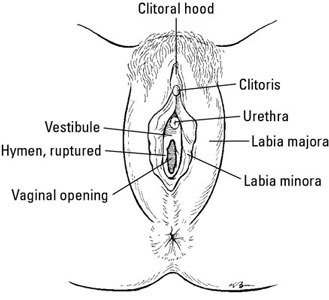As a child is born, this system is immature, and it begins to mature when the child reaches puberty. The clitoris is a structure roughly the size of a pea that is found at the top of a woman’s vulva, above the opening of the urethra. It is a little structure with a pea-like shape. It is the male homolog of the clitoris; however, unlike the clitoris, it does not normally contain any of the distal section of the urethra, therefore it is not used for urination. In addition, the clitoris is frequently devoid of reproductive abilities.
The clitoris is the most sensitive erogenous zone in a female, and it is present in humans. It is believed that the clitoris develops from a protrusion in the embryo known as the genital tubercle, which is present in all mammals except humans. Depending on how much androgen is present in the environment, the tubercle will either develop into a penis or a clitoris throughout the development of the reproductive system. Because it is a complicated anatomy, the size and sensitivity of the clitoris can vary. This sensory nerve ending-rich structure is around the size and shape of a pea, and it is estimated to contain approximately 8,000 sensory nerve endings.
Clitoris Diagram

Clitoris’s Location
The vulva is a phrase that is commonly used to describe all of the exterior female genital organs, including the cervix. In and around the vagina, there are several organs that are important to know about. These organs include the labia minora and majora as well as the vaginal vestibule, labia clitoris, vestibule bulb, and the glands of Bartholin.
To generate an oval shape, the two types of labia are joined together around the vaginal opening. The labia minora is the lesser portion of the labia majora that surrounds the vagina. Upon reaching puberty, the labia majora becomes the bigger section of the genital area; the outer region of the labia majora is covered with pubic hair. The point at which the labia majora comes together is the point at which the labia majora are created.
Parts of the Clitoris that are visible from the outside
In the clitoris, the glans clitoris is regarded as the exterior portion of the clitoris. It is located above the urethra and is around the size of a pea in terms of physical dimensions. It is because the glans are the most extraordinarily sensitive and the most densely innervated part of the clitoris that they are used.
This structure, which is created by the two sides of the connecting labia minora, is present on the top of the glans or just above it and is present on the top of the glans or just above it. The size and degree of coverage provided by the clitoral hoods might vary from person to person, depending on the individual.
Parts of the Clitoris’s internal structure
The glans of the clitoris connects the body of the clitoris to the external part of the clitoris, which is known as the glans of the clitoris. The clitoris’s body is protruded upwards, leading to the pelvis, and it is connected to the pubic bone by a number of ligaments that are joined to the pubic bone. It is split in half to form the paired crura and vestibular bulbs, which are formed when the clitoris divides in half. It is these bulbs that extend through and behind the labia, as well as the route that passes via the urethra and vaginal canal, on its way to the anus.
In spider monkeys, the clitoris is uniquely formed and has an internal tube, or urethra, that makes it nearly identical to the penis in appearance. Its function is to collect and disseminate urine droplets when the female spider monkey moves around. Female spotted hyenas, on the other hand, are sometimes referred to as hermaphrodites. These female spotted hyenas have a big clitoris, which aids them in performing a variety of tasks such as mating, urinating, and giving birth. Some other species, such as lemurs and spider monkeys, have enormous clitoris that are similar in size to the human clitoris.
Conclusion
The clitoris is widely considered to be the most essential organ in females. The size of a female might vary from one individual to another. However, the clitoris is not only significant and present in humans, but it is also present in all mammalian species, with certain mammalian species, such as spider monkeys and lemurs, having a larger clitoris than others.